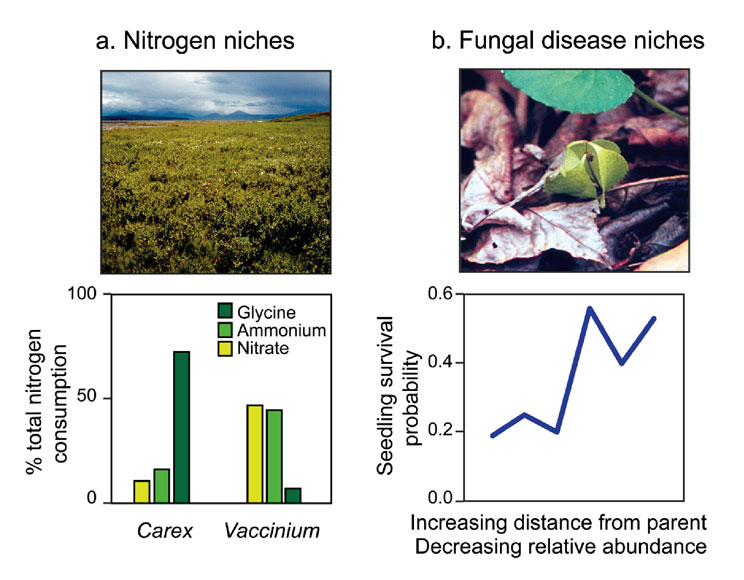What Best Describes the Ecological Diversity of North America
Ecological and Cultural Edges as Sources of Diversity for SocialEcological Resilience Nancy J. When goats were introduced to an island of the California coast the goats inhabited the same areas and ate the same plants as the native deer.

The Maintenance Of Species Diversity Learn Science At Scitable
For example trees provide habitat and nutrients for birds insects other plants and animals fungi and microbes.

. Bentrup Iowa State University Ames Iowa University of Nebraska - Lincoln. North Northwest and Northeast China. Ecology is the study of the relationships between living organisms including humans and their physical environment.
2006 to generate important ecological diversity Fig. The observation that large fires in boreal North America accen- tuate climatic and terrain differences Chapin et al. This is an example of _________.
To investigate the genetic diversity and population structure of foxtail millet from different ecological zones of China 90 accessions of foxtail millet were collected from three major ecological areas. Domestication increases the ability of wild organisms to breed in captivity and produce offspring with desired traits. Aim To evaluate the relationship of climate and physiography to species density and ecological diversity of North American mammals.
3 September 2003 C 2003 Living on the Edge. Location North America including Mexico and. As humans tamed wild organisms to amplify desired traits genetic diversity decreased in the organisms populations.
5Nicholas School of the Environment and Earth Sciences Duke University Durham North Carolina 27708 USA Abstract. White-breasted nuthatches and Downy woodpeckers both eat insects that hide in the furrows of bark in hardwood trees. A comprehensive history of the continent full of engaging and attention-catching information about North Americas geology climate and paleontology The Washington Post Book World.
The statement that best describes the ecological diversity of North America is that North America is somewhat diverse and has about seven ecological regions. Can be as little as 200 mm and on the east coast it can be as high as exceeding 1000 mm. According to CEC Ecological Regions of North America snow and freshwater ice can occupy the taiga for half to three quarters of the year.
The niche of an animal is. Bezglasnaaz and 23 more users found this answer helpful. The goal of this process is to emulate the structure and function of the specified ecosystem.
The following ecosystems exist in North. The way the animal fits into its enviornement. USDA Forest Service National Agroforestry Center USDA Forest Service UNL Faculty Publications University of Nebraska - Lincoln Year Ecological Development and Function of Shelterbelts in Temperate North America C.
Davidson-Hunt2 and Michael OFlaherty3 A well-known facet of ecosystems is that the edgesthe boundaries or transi- tions from one ecosystem to anotheroften exhibit high levels of species. Which of the following best describes an unintended consequence of this practice. The 1980s definition of ecological restoration is the process of altering a site to establish a defined indigenous historic ecosystem.
Godfray et al 2000. BRADFORD3 AND ROBERT B. North America is characterized by a wide range of ecosystems a dynamic geological history and significant insect diversity Danks 1994.
Having a diverse array of living organisms allows other organisms to take advantage of the resources provided. Although researchers have begun cataloging the incredible diversity of bacteria found in soil we are largely unable to interpret this information in an ecological context. Here the rock star of modern science tells the unforgettable story of the geological and biological evolution of the North American continent from the time of the asteroid strike.
Humans have always depended on the Earths biodiversity for food shelter and health. Conceptual diagram of a multi-scale prioritization strategy for refugia identification and landscape-level adaptation planning. The deer population dwindled and finally disappeared.
Ecology also provides information about the benefits of ecosystems and how we can use Earths resources in ways that leave the. It seeks to understand the vital connections between plants and animals and the world around them. The prolamin contents were examined by acid polyacrylamide gel electrophoresis acid-PAGE.
2007 by the Ecological Society of America TOWARD AN ECOLOGICAL CLASSIFICATION OF SOIL BACTERIA NOAH FIERER 126 MARK A. Ecology 886 2007 pp. The Downy woodpecker searches for insects by hunting from the bottom of the tree trunk toward the top whereas the white-breasted nuthatch searches from the top of the trunk down.
Butterflies are distributed across 14 broad ecoregions ranging from the eastern temperate forests to tundra and taiga in Northern Canada tropical wet forests in southern Mexico and the warm and cold. The ecological diversity of North America can be best described as rich with natural resources that provide the basis of a expansive network of ecosystems. The bivariate distribution of elevational diversity and backward climatic velocity values for 1 km2 cells pixels in North America indicating their relative value as macro- y-axis and microrefugia x-axis.
A CEC Ecological Regions of North America document states that the lowest average precipitation is on the western side of taiga.

The Graph Here Shows The Population Sizes Of Different Kinds Of Plants During Primary Brainly Com

Apes Midterm Flashcards Quizlet

Ecology Exam Chapters 12 13 14 20 22 25 Flashcards Practice Test Quizlet
No comments for "What Best Describes the Ecological Diversity of North America"
Post a Comment